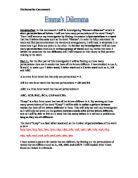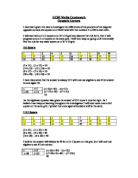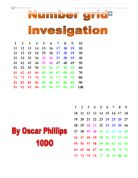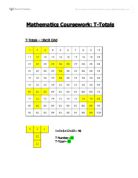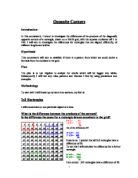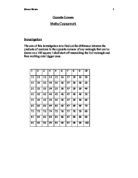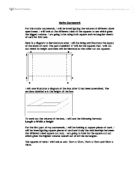Emma's Dillemma
. Emma 2 Emam 3 Eamm 4 Aemm 5 Amem 6 Amme 7 Meam 8 Mema 9 Mame 0 Maem 1 Mmae 2 Mmea There are 12 different arrangements of Emma 2. Lucy 2 Luyc 3 Lyuc 4 Lycu 5 Lcuy 6 Lcyu 7 Culy 8 Cuyl 9 Cylu 0 Cyul 1 Cluy 2 Clyu 3 Yclu 4 Ycul 5 Ylcu 6 Yluc 7 Yucl 8 Yulc 9 Ulcy 20 Ulyc 21 Uylc 22 Uycl 23 Uclu 24 Ucul There are 24 different arrangements of Lucy 3. Jo 2 Oj Joe 2 Jeo 3 Eoj 4 Ejo 5 Oje 6 Oej Ann 2 Nan 3 Nna JJ Number of Letters With Repeated Letters No Repeated Letters JJ Jo 2 2 Ann Joe 3 3 6 Emma Lucy 4 2 24 The "no repeated letters" field is equal to the "With repeated letters" field but doubled i.e Lucy = 4 letters = 24 arrangements all you need to do then is to divide it by 2 and you will have the value of "With repeated letters" field and visa versa. There is a quicker solution to this problem. All that you need to do is (If you need a 4 letter word) you would do 1x2x3x4. If you needed 5 letters you would do 1x2x3x4x5 and so on. If you want to find out the value of the repeated letters field you would then just divide it by 2. I predict that a 5 letter word will have 120 combinations because 1x2x3x4x5 = 120. 20 combinations will be too much so I will do a 5-letter word that has a repeated letter such as Barry Larry or Annie. This will, according to my theory
Emma's dillemma
Introduction: In this coursework I will be investigating "Emma's dilemma" which is about permutations of letters. I will see how many permutations of the word "Lucy". Then I will continue my investigation by finding the amount of permutations in a word that has 2 letters the same such as the word "Emma". In order to fully understand the work and find patterns between the words and arrangements, I will need to structure it to show how I got from one point to the other. To further my investigation I will see how many permutations there are in various groups of words such as, words that have 3 letters the same and the rest different, and I will expand on this theory to find patterns relating to the work. Part 1: For the first part of this investigation I will be finding out how many permutations there are in words that have all the letters different. I have decided to use A, B and C to make up a 1 letter word, 2 letter word and a 3 letter word such as A, AB and ABC. A is a one letter word that has only one permutation = A AB is a two letter word that has two permutations = AB and BA ABC is a three letter word that has six permutations = ABC, ACB, BAC, BCA, CAB and CBA. "Lucy" is a four letter word that has all the letters different in it. By working out how many permutations of the word "Lucy" I will be able to notice a pattern between words that have all the letters
emmas dilema
Emma's Dilemma Emma and Lucy are playing with arrangements of their names. One arrangement of Lucy is L U C Y A different arrangement is Y L C U Part 1 Investigate the number of different arrangements of the letters of Lucy's name. Part 2 Investigate the number of different arrangements of the letters of Emma's name. Part 3 Investigate the number of different arrangements of various groups of letters. Part 1 Set 1 Set 2 Set 3 Set 4 LUCY UCYL CUYL YCUL LUYC UCLY CULY YCLU LCUY ULCY CLUY YLUC LCYU ULYC CLYU YLCU LYCU UYCL CYUL YULC LYUC UYLC CYLU YUCL I have investigated the number of arrangements of the letters of Lucy's name in an organized way. I have written them out in sets with Set 1 beginning with L. Set 2 with U, Set 3 with C and Set 4 with Y. in each set the arrangements are written out in an order i.e. in set 1 the first 2 arrangements begin with LU, the 2 after that begin with LC and the 2 after that begin with LY. There are 24 different arrangements. Examples If it is just one letter then you cannot change it. If it is two letters like AB then it can be changed into AB or BA and there are 2 arrangements. If there are three letters like ABC then there are 6 arrangements. I organized this so that set 1 begins with A, set 2 with B and set 3 with C. Set 1 Set 2 Set 3 ABC BAC CAB ACB BCA CBA If there are four
Emmas dilemma
Investigation I am first going to write out all the combinations for the name Emma. emma eamm emam meam maem mmea mmae mema mame amme aemm amem This proves that if a name has the same arrangements of letters they will have the same total number of different combinations. However, this does not give me sufficient information to develop a formula. I am now going to look at names with 2 letters the same like Emma, but with a different total number of letters. I am going to look at all the combinations for the name Lucy. Lucy has 24 different combinations. This means that all names with 4 different letters will have a total of 24 different combinations. I am now going to look at different names with different numbers of letters. All the names I investigate will all have different letters. Name: Jo Total number of letters: 2 jo oj Jo has 2 different combinations. Name: Ian Total number of letters: 3 ian ina ani ain nai ain Ian has 6 different combinations. I have realised that the total number of combinations is the number of letters multiplied by the previous number of combinations. Name: Lucy Total number of letters: 4 Previous number of combinations: 6 Prediction: 4 x 6 = 24 lucy luyc lcyu lcuy lycu lyuc ulcy ulyc uylc uycl ucly ucyl cluy clyu culy cuyl cyul cylu yluc ylcu yclu ycul yucl yulc As i predicted
Investigate the relationship between the T-total and the T-number
T-Total and T-Number Coursework INTRODUCTION PART 1: INVESTIGATE THE RELATIONSHIP BETWEEN THE T-TOTAL AND THE T-NUMBER T-NUMBER T-TOTAL 20 37 21 42 22 47 23 52 24 57 The table above shows the difference between the consecutive T-Totals as the T-Number increases by one. On grid sheet 1, the T-Shapes can be seen being translated across the 9 x 9 grid by one square each time. There is a pattern between the T-Totals as the T-Shape is translated each time, as each time the T-Total increases by 5, as shown in the table above. Each T-Total on the diagrams increases by 5 each time it is translated one square across. This is because each square in the T-Shape increases by one each time it is translated, and as there are 5 squares in the T-Shape, a total increase of 5 is calculated for the T-Total. Already from this, I can begin to create a formula for working out the T-Total for any T-Shape on a 9 x 9 grid. n-19 n-18 n-17 n-9 n The formula shown in the T-Shape above should work out the T-Total for any T-Shape on a 9 x 9 grid. I now plan to test this theory, by taking a few random sample T-Numbers from the 9 x 9 grid and using the formula to work out the T-Total. I think that my formula is correct, and that it will give the correct T-Total each time, but I will check it anyway. 24 25 26 34 43 The T-Number of the T-Shape is 43. Using my formula, I can work
Investigate the relationship between the T-total and the T-number.
GCSE Math's Investigation Introduction In this investigation I'm going to investigate the relationship between the T-total and the T-number. What I'm going to do is use different sizes of grids for example 9*9, 8*8, 7*7, 6*6, 5*5 and 4*4. To compare the answers I will have to investigate each grid for a few times for example 9*9 grid will be investigated for at list three times. I will have to make predictions for each of the grids. I will also have to translate and compare different positions of the T-shape and the T-numbers. After I have finished the investigation I will then evaluate and compare the relationships between different sizes of grids. The first grid I will investigate will be the 9*9 grid. 2 3 4 5 6 7 8 9 0 1 2 3 4 5 6 7 8 9 20 21 22 23 24 25 26 27 28 29 30 31 32 33 34 35 36 37 38 39 40 41 42 43 44 45 46 47 48 49 50 51 52 53 54 55 56 57 58 59 60 61 62 63 64 65 66 67 68 69 70 71 72 73 74 75 76 77 78 79 80 81 2 3 1 20 T-number = 20 T-Total = 1+2+3+11+20=37 T20=37 n-19 n-18 n-17 n-9 n T-number = n T-Total = n+n-9+n-17+n-18+n-19 Tn = 5n-63 T-number = 20 Tn = 5n-63 20 * 5 = 100 -63 37 Here is another 9*9 grid I will use the similar method just like the one on the first page and see what I gate for this second one. The difference between these is that the
Investigation in to the relationships between IQ results, Key stage 2 results and gender in secondary school students
Maths Coursework - Statistics Introduction We are going to investigate the relationships between IQ results, Key stage 2 results and gender in secondary school students. The school that we are using to gather information for our sample from, Mayfield, is a fictitious high school. However, the data that is presented is still based on a real school and real students. Hypothesis I predict that this investigation will prove that girls are more intelligent than boys. There are plenty of surveys that show that key stage 2 results are higher for girls than boys. Although these surveys may be questionable, as there would be some exceptions. Plan By comparing the differences between the 3 factors, for girls and boys, we will be able to determine which gender is more intelligent. We will be using a random sample of 100 students - 50 boys and 50 girls. These 100 students will be selected randomly from year 7. We will then use this sample to analyse the information and make judgements about it. We will make graphs and charts to show our results, which we will use to draw our conclusions on our information. In order to obtain our sample, we did some stratified random sampling. This means that we took 50 boys and 50 girls form year 7, but used the random numbers generator on our calculator to pick which students would be selected for our sample. We did this so that the information
Investigation into T-shapes.
Investigation into T-shapes Looking at the 9-9 grid below and the T-shape drawn on it, The total number of the numbers on the inside of the T-shape is called the T-total 2 3 4 5 6 7 8 9 0 11 12 13 14 15 16 17 18 9 20 21 22 23 24 25 26 27 28 29 30 31 32 33 34 35 36 37 38 39 40 41 42 43 44 45 46 47 48 49 50 51 52 53 54 55 56 57 58 59 60 61 62 63 64 65 66 67 68 69 70 71 72 73 74 75 76 77 78 79 80 81 82 83 84 85 86 87 88 89 90 The t-total for this T-shape is: +2+3+11+20=37 so 37 = T-total The number at the bottom is the T-number, so the T-number for this shape is 20 Aims: ) Investigate the relationship between the T-total and the T-number 2) Use the grids of different sizes. Translate the T-shape to different positions. Investigate relationships between the T-total and the T-number and the grid size. 3) Use grids of different sizes again, try other transformations and combinations of transformations. Investigate relationships between the T-total and the T-number and the grid size and the transformations. Aim 1- the solution 2 3 4 5 6 7 8 9 0 11 12 13 14 15 16 17 18 9 20 21 22 23 24 25 26 27 28 29 30 31 32 33 34 35 36 37 38 39 40 41 42 43 44 45 46 47 48 49 50 51 52 53 54 55 56 57 58 59 60 61 62 63 64 65 66 67 68 69 70 71 72 73 74 75 76 77 78 79 80 81 82 83 84 85 86 87 88 89 90 T69= 50+51+52+60+69 =282 T22=3+4+5+13+22 =47 in the diagram below it
Personal Exercise Program
GCSE PE COURSEWORK Task: Plan a training programme for a specific activity. I have decided that I am going to use football as the activity that my training programme is going to be based on. I will perform my circuit in the gym. My general health is very good. I do not suffer from asthma or any other breathing problems and I have no allergies. I eat quite healthily getting lots of carbohydrates especially as well as proteins, starch, vitamins and all the required fats. Firstly I am going to show how much exercise I would do in a typical week. * 3 hours of in school games lessons * Half an hour of football training for school * 45 minutes of cricket training for school * 1 hour of football training for Bishops Lydeard YFC * 1 hour and 20 minutes matches on Sundays Bishops Lydeard YFC. * 1 hour cricket training for Fitzhead CC * 3-4 hours of football at lunch break for leisure As you can see I am already a very active person which helps me towards being a very fit person. Stamina is my main strength which is why I normally compete in long distance events on sports days and I am good at the bleep test. It is for all these reasons that I will be trying to push myself to my limit. The two areas of specific fitness I will be working on to make my performance levels in football higher are AGILITY and UPPER BODY STRENGTH. Agility is a major component of football. Being
There are many different newspapers; they range from tabloid papers to the broadsheet papers. The tabloids are a lighter read to the more involving descriptive broadsheet papers. Different newspapers are written to suit these preferences.
Introduction There are many different newspapers; they range from tabloid papers to the broadsheet papers. The tabloids are a lighter read to the more involving descriptive broadsheet papers. Different newspapers are written to suit these preferences. In the tabloid papers the wording used is less profound and therefore more easily understood. Aim To find if a tabloid paper gives a more "easier" read than a broadsheet paper Prediction A broadsheet paper will have more letters on average per word than a tabloid paper. Objectives 1.To collect data on number of letter per word in two papers. 2.To present data in a meaningful way 3.To interpret and analyse results and diagrams 4.To draw conclusions on analysis, state whether the prediction is correct. Method The data will be collected in-groups as this saves time. Every fourth word in a report will have the numbers of letters counted in it. This should give a good overall view to the word length in a section. Similar sections from each newspaper will be counted as to keep it fair. For example sports will be counted from newspapers, so will economics and politics. This is to give an overall view of the newspapers and so not just one area is studied. From each section the same number of words will be used to keep the investigation fair. Interpretation/ Analysis By looking at the tally charts and box plots for both The



